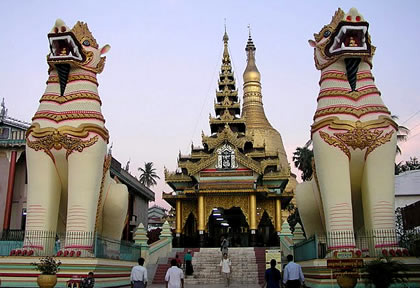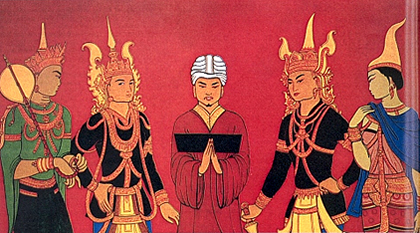World History
The Mon may have been the first human inhabitants of Myanmar, better known as Burma. The Mon are also known as the Taliang people. They migrated, perhaps pursued by enemies, to South Burma, where they lived near the Salween River, which empties into the Bay of Bengal, not far east of the border with Thailand. Their population spread into Thailand as well.
In 573 two Mon brothers named Prince Samala and Prince Wamala created the kingdom of Hongsavatoi, which is located near the modern city of Pegu. The Mon realm enjoyed independence for several centuries. However by the middle of the 11th century, the Mon peoples came under the influence of those we now call Burmese, who had formed the kingdom of Pagan.
A Buddhist monk of the Mon people converted the first king of Pagan, Anawratha (r. 1044–77), to Theravada Buddhism. This religion was common in Southeast Asia, so the Pagan takeover may have been less of a conquest, and more assimilation.
Both the Mon and the Burmese were under the strong influence of India and used Indian Sanskrit in some of their writings. The Pagan kingdom refused to pay tribute to the conquering Mongols, believing their distance from Mongol-controlled China would provide protection. In 1287 Kubilai Khan, the founder of China’s Yuan dynasty (1279–1368), sent an army south, which virtually destroyed Pagan in revenge.
At this time the Mon, with the reduction of Pagan, came under the rule of an adventurer from the Thai people, who established the Mon kingdom of Râmaññadesa, which was formed from the three provinces of Bassein, Pegu, and Martaban; the city of Pegu became the new kingdom’s first capital.
The Râmaññadesa kingdom was brutally attacked in 1540 by the Burmese from Taungu, who went on to virtually unite all of modern Burma. With this invasion, Mon political independence was extinguished, but their cultural and nationalist identity remained strong, as it has until today.
In the 18th century the Mon temporarily threw off Burmese rule, only to invite a brutal repression in return. At the same time as Robert Clive was expanding British rule in India, the Burmese ruler U Aungzeya began a genocidal invasion of the Mon heartland.
As Dr. George Aaron Broadwell writes, the invasion “devastated the Mon kingdom, killing tens of thousands of Mon, including learned Mon priests, pregnant women, and children. Over 3,000 priests were massacred by the victorious Burmans in the capital city alone....
The surviving priests fled to Thailand, and Burman priests took over the monasteries. Most of the Mon literature, written on palm leaves, was destroyed by the Burmans. Use of the Mon language was forbidden, and Burman became the medium of instruction.
Mon people were persecuted, oppressed, and enslaved, and countless people were burned in holocausts, like the Jews before the Nazis. Mon properties and possessions were looted and burned throughout Burma. Mons fled further south into Burma’s Tenasserim Division and east into Thailand.â€
Afterward the Mon remained firmly under Burmese control. The Alompra Burmese dynasty in the 18th and 19th centuries continued U Aungzeya’s policy with a policy of forcibly eradicating the Mon language and culture, attempting a compulsory assimilation into the Burmese majority. The Mon managed to preserve their culture, and records of the kingdom of Râmaññadesa were written and preserved in the Mon language.
The Burmese came under British rule in the 19th century, after the First Burma War (1824–26), Second Burma War (1852–53), and the Third Burma War (1885–87). The British ruled Burma, with a hiatus during World War II, until independence in 1948. After independence the Burmese continued their oppression of the Karen, Shan, and Mon peoples.
For her opposition to Burmese military rule, Daw Aung San Suu Kyi received the Nobel Prize in peace in 1991. Mon people exiled from their native land have continued to battle for international recognition of their culture, language, and freedom.
- Burma
Burma The classical civilization of Burma (Myanmar) is centered at Pagan. After the collapse of the Pyu state, the Mrammas (Sanskritized Brahma), or Burmans, founded their chief city, Pagan (Arimarddanapura or “City Where Enemies Were Exterminatedâ€)...
- Dvaravati
Dvaravati map The Mon kingdom of Dvaravati (also called Siam) flourished in what is now Thailand from the sixth century c.e. to around the 11th century. The kingdom covered the political area of Nakhon Pathom (west of present-day Bangkok), U-Thong, and...
- Tabin Swehti
Tabin Swehti was the Burmese king who helped to unify the country as part of what is known as the Second Burmese Empire or the Toungoo dynasty, created by his father, Minkyinyo, in 1486 and lasting until 1752. However, it was Tabin Swehti who was responsible...
- History Links Relating To Myanmar (burma)
The country formerly known as Burma (Myanmar) is at the top of the news right now. The monks protesting the military dictatorship there coupled with President Bush's speech before the United Nations have focused world attention on this nation. This...
- History Of Thailand
History of Thailand. This is a good short essay on the history of the Asian nation of Thailand. Wikipedia notes, "The Kingdom of Thailand is a country in Southeast Asia, bordering Laos and Cambodia to the east, the Gulf of Thailand and Malaysia to the...
World History
Mon
 |
| Mon kingdom |
The Mon may have been the first human inhabitants of Myanmar, better known as Burma. The Mon are also known as the Taliang people. They migrated, perhaps pursued by enemies, to South Burma, where they lived near the Salween River, which empties into the Bay of Bengal, not far east of the border with Thailand. Their population spread into Thailand as well.
In 573 two Mon brothers named Prince Samala and Prince Wamala created the kingdom of Hongsavatoi, which is located near the modern city of Pegu. The Mon realm enjoyed independence for several centuries. However by the middle of the 11th century, the Mon peoples came under the influence of those we now call Burmese, who had formed the kingdom of Pagan.
A Buddhist monk of the Mon people converted the first king of Pagan, Anawratha (r. 1044–77), to Theravada Buddhism. This religion was common in Southeast Asia, so the Pagan takeover may have been less of a conquest, and more assimilation.
  |   |
Both the Mon and the Burmese were under the strong influence of India and used Indian Sanskrit in some of their writings. The Pagan kingdom refused to pay tribute to the conquering Mongols, believing their distance from Mongol-controlled China would provide protection. In 1287 Kubilai Khan, the founder of China’s Yuan dynasty (1279–1368), sent an army south, which virtually destroyed Pagan in revenge.
At this time the Mon, with the reduction of Pagan, came under the rule of an adventurer from the Thai people, who established the Mon kingdom of Râmaññadesa, which was formed from the three provinces of Bassein, Pegu, and Martaban; the city of Pegu became the new kingdom’s first capital.
The Râmaññadesa kingdom was brutally attacked in 1540 by the Burmese from Taungu, who went on to virtually unite all of modern Burma. With this invasion, Mon political independence was extinguished, but their cultural and nationalist identity remained strong, as it has until today.
In the 18th century the Mon temporarily threw off Burmese rule, only to invite a brutal repression in return. At the same time as Robert Clive was expanding British rule in India, the Burmese ruler U Aungzeya began a genocidal invasion of the Mon heartland.
 |
| Mon costumes |
As Dr. George Aaron Broadwell writes, the invasion “devastated the Mon kingdom, killing tens of thousands of Mon, including learned Mon priests, pregnant women, and children. Over 3,000 priests were massacred by the victorious Burmans in the capital city alone....
The surviving priests fled to Thailand, and Burman priests took over the monasteries. Most of the Mon literature, written on palm leaves, was destroyed by the Burmans. Use of the Mon language was forbidden, and Burman became the medium of instruction.
Mon people were persecuted, oppressed, and enslaved, and countless people were burned in holocausts, like the Jews before the Nazis. Mon properties and possessions were looted and burned throughout Burma. Mons fled further south into Burma’s Tenasserim Division and east into Thailand.â€
Afterward the Mon remained firmly under Burmese control. The Alompra Burmese dynasty in the 18th and 19th centuries continued U Aungzeya’s policy with a policy of forcibly eradicating the Mon language and culture, attempting a compulsory assimilation into the Burmese majority. The Mon managed to preserve their culture, and records of the kingdom of Râmaññadesa were written and preserved in the Mon language.
The Burmese came under British rule in the 19th century, after the First Burma War (1824–26), Second Burma War (1852–53), and the Third Burma War (1885–87). The British ruled Burma, with a hiatus during World War II, until independence in 1948. After independence the Burmese continued their oppression of the Karen, Shan, and Mon peoples.
For her opposition to Burmese military rule, Daw Aung San Suu Kyi received the Nobel Prize in peace in 1991. Mon people exiled from their native land have continued to battle for international recognition of their culture, language, and freedom.
- Burma
Burma The classical civilization of Burma (Myanmar) is centered at Pagan. After the collapse of the Pyu state, the Mrammas (Sanskritized Brahma), or Burmans, founded their chief city, Pagan (Arimarddanapura or “City Where Enemies Were Exterminatedâ€)...
- Dvaravati
Dvaravati map The Mon kingdom of Dvaravati (also called Siam) flourished in what is now Thailand from the sixth century c.e. to around the 11th century. The kingdom covered the political area of Nakhon Pathom (west of present-day Bangkok), U-Thong, and...
- Tabin Swehti
Tabin Swehti was the Burmese king who helped to unify the country as part of what is known as the Second Burmese Empire or the Toungoo dynasty, created by his father, Minkyinyo, in 1486 and lasting until 1752. However, it was Tabin Swehti who was responsible...
- History Links Relating To Myanmar (burma)
The country formerly known as Burma (Myanmar) is at the top of the news right now. The monks protesting the military dictatorship there coupled with President Bush's speech before the United Nations have focused world attention on this nation. This...
- History Of Thailand
History of Thailand. This is a good short essay on the history of the Asian nation of Thailand. Wikipedia notes, "The Kingdom of Thailand is a country in Southeast Asia, bordering Laos and Cambodia to the east, the Gulf of Thailand and Malaysia to the...
